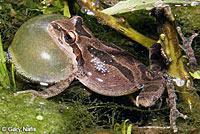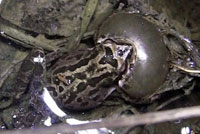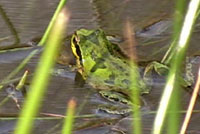
A Guide to California's
Reptiles and Amphibians
Sounds of
Baja California Treefrog -
Pseudacris hypochondriaca hypochondriaca
(Hallowell, 1854)
(= Pacific Chorus Frog, = Pacific Treefrog. See Alternate Names)
|
Male frogs and toads sometimes make a variety of sounds. These calls can have different functions. Advertisement Calls The advertisement call is the most well-known call of a frog or toad. It is made by a male during the breeding season to establish his territory and repel rival males and to attract females as potential mates. Males usually make the call in or near bodies of water near areas that are attractive to a female as a good place to lay her eggs. Advertisement calls can be heard during the evening and at night, and often during daylight at the peak of the breeding season. Sometimes an advertisement call will be heard outside of the breeding season and away from water. The reason for this is not understood. Each species has its own unique advertisement call. This is necessary to differentiate them when there is more than one species calling. The evolution of this specific male advertisement call and its recognition by females is considered to be an important isolating mechanism in the evolution of a species. The Baja California Treefrog produces two different kinds of very loud advertisement calls: a two-part, or diphasic call, typically described as rib-it, or krek-ek, with the last syllable rising in inflection, and a one-part, or monophasic call, also called the enhanced mate attraction call. |
||
| The call of the Baja California Treefrog is known throughout the world through its wide use as a nighttime background sound in many Hollywood movies, even those which are set in areas well outside the range of this frog. The call of the Baja California Treefrog is identical to that of the Sierran Treefrog and the Pacific Treefrog, and it is possible that the calls of all of these species were also used as movie sound effects. |
||
Diphasic (two-part) Call This call is produced during the day and at night, often in large choruses. |
||
| This is a very short recording of a single Baja California Treefrog calling two times at night in a riparian canyon in San Diego County (shown to the right.) |  |
|
| This is a 31 second recording of a small group of Baja California Treefrogs calling two times at night in a riparian canyon in San Diego County (shown to the right .) Insect noises are heard in the background. | ||
| This is :53 of a chorus of frogs starting up then winding down recorded at night in Kern County on the banks of a river (shown to the right.) | 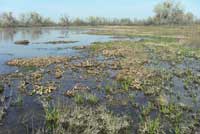 |
|
 |
||
| This is short recording of one frog calling at night from a small pond in Nye County, Nevada (shown to the right.) |
||
| This is 37 seconds of a large group of frogs calling at night from a small pond in Nye County, Nevada (shown to the right.) | ||
| Waveform and Sonogram | ||
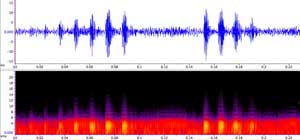 |
||
| |
This is a recording of one repetition of the advertisement call of a Baja California Treefrog recorded at night in San Diego County. The image above is a visual representation of this call. Click on it to see a larger image. Click here for information about how to read the waveform and sonogram images. |
|
| |
||
Monophasic (one-part) (enhanced) Call This call is produced during the day and at night. It is produced at a high rate when a male is approached by a female, and he continues to produce it until he has amplexed the female. |
||
| |
This is a 12 second recording of the monophasic call made by male Sierran Treefrogs. It was recorded at about 9,000 ft. in Alpine County in late June at the beginning of the breeding season when the snow was melting around the breeding pond. Another deeper single-note call is heard along with birds and flowing water. (This sound is the same as the sound made by the Baja California Pacific Treefrog.) |
|
Trilled Encounter Call The trilled encounter call is a raspy trilled sound. It is an aggressive signal aimed at other males and is used to establish spacing between them at the calling site during a breeding chorus. The encounter call is typically heard during the beginning of the chorus when territories are being established and then later when a male intrudes on the territory of another male either physically or with very loud calling. |
||
| |
This is a 7 second recording of trilled encounter calls made by male Baja California Treefrogs, recorded at a desert marsh in San Bernardino County (shown to the right) in mid March on a sunny afternoon. The recording starts with some typical advertisement calls, then ends with three trilled calls. | 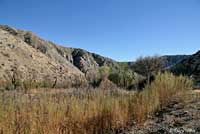 |
| |
This is a 4 second recording of trilled encounter calls made by male Baja California Treefrogs, recorded at a desert marsh in San Bernardino County (shown to the right) in mid March on a sunny afternoon. The recording begins with one trill and ends with a second one. Normal advertisement calls can also be heard. | |
| |
This is :09 of a chorus of frogs recorded at night at the edge of a river in Kern County (shown to the right.) Three encounter calls are heard that are slightly louder than the chorus. |
 |
| |
This is :18 of a chorus of frogs recorded at night at the edge of a river in Kern County (shown to the right.) in which you can hear several encounter calls. |
|
| Land Call The land call is a prolonged one-note kr-r-r-ek sound. Land calls can be heard during the day, often in wooded areas away from water. I have heard frogs produce this call while they were sitting high on a tree branch as well as when they were on the ground, usually hidden in dense vegetation. The call is sometimes referred to as the "Fall awakening call" and it does appear to be made mostly during Fall when the rains are beginning and the frogs are coming out of their summer slumber. |
||
| This is a 36 second recording of the land calls of a single Sierran Treefrog during daylight in November near a pond beside the ocean in Marin County. Ocean waves, other distant treefrog land calls, and a few birds are heard in the background. (This sound is the same as the sound made by the Baja California Treefrog.) |
||
Release Call The release call is made by a frog when another male frog attempts to clasp its back in amplexus. A frog will also produce this call when it is grabbed across the back by a human, and probably also when it is grabbed by other types of predators. |
||
| This is a 5 second recording of 3 release calls produced by a male Sierran Treefrog in breeding phase as it was grabbed across the back. (The frog was not harmed.) Recorded in Alpine County. (This sound is the same as the sound made by the Baja California Treefrog.) | ||
| Short Videos | ||
You can listen to more recordings of Baja California (Pacific) Treefrogs on this cd: Carlos Davidson - Frog and Toad Calls of the Pacific Coast  and on the cd that comes with this book: Lang Elliott, Carl Gerhardt, and Carlos Davidson - The Frogs and Toads of North America - Houghton Mifflin Harcourt. 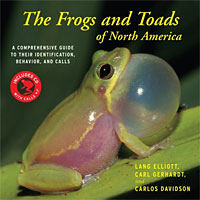 |
||
Return to the Top
© 2000 -
